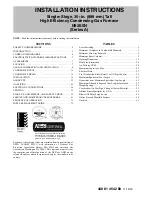
4.0 3216 Controller
Working Output Power
From the home display, press scroll
until the display shows WRK.OP <WORKING
OUTPUT POWER>. This shows the power being used as a percentage.
Time Remaining
Press scroll
until the display shows T.REMN <TIME REMAINING>. This shows the dwell
time remaining for the current segment. There is no value for “Ramp Time Remaining”
therefore when the program is ramping the dwell time set will be shown and will only
begin to count down when the ramp has finished.
Program Review
Further presses of scroll
will reveal the settings of the current program operating.
These parameters are locked, while the program is operating.
Program Hold with Holdback
If a holdback value has been set (see section 4.6) and the program goes into a hold
state, the red “HLD” indicator will light, until the current temperature catches up.
If while in this condition the program itself is put into “Hold” by pressing the up
, down
together, the “HLD” indicator will turn off and the “Run” indicator will flash, indicating
the program is on hold. When the program is started again by pressing the up
, down
together, the “Run“ indicator will stop flashing and show continually and the “HLD”
indicator will light, if the current temperature has not caught up with the program.
Power Failure
If there is a power failure while the program is operating and the power is subsequently
restored, the scrolling text will read <POWER FAIL - PROGRAM RESET>.
Press the “ACK” function to acknowledge this message, press the “ACK” function again
to reset the program.
Alarms
Alarms are used to alert the operator when a pre-set level has been exceeded or a
function error has occurred such as a sensor break. They are indicated by a scrolling
message on the display and a flashing red ALM (Alarm) indicator. The alarm may also
switch an output – usually a relay to allow external devices to be operated when an
alarm occurs. Alarms only operate if they have been configured and are dependent on
customer requirements.
How to acknowledge an alarm will depend on the type of latching which has been
configured. A non-latched alarm will reset itself when the alarm condition is removed. A
latched alarm requires acknowledgement with the “ACK” function before it is reset.
If an alarm has been activated the red “ALM” indicator will light and the scrolling text will
indicate the type of alarm.
To acknowledge an alarm and cancel the “ALM” indicator, press “ACK” function.
Note: The alarm indicator may seem to be permanently on when viewed from above.
When an alarm is active the indicator should only be flashing, to confirm this, the
controller must be viewed directly from the front.
22
















































